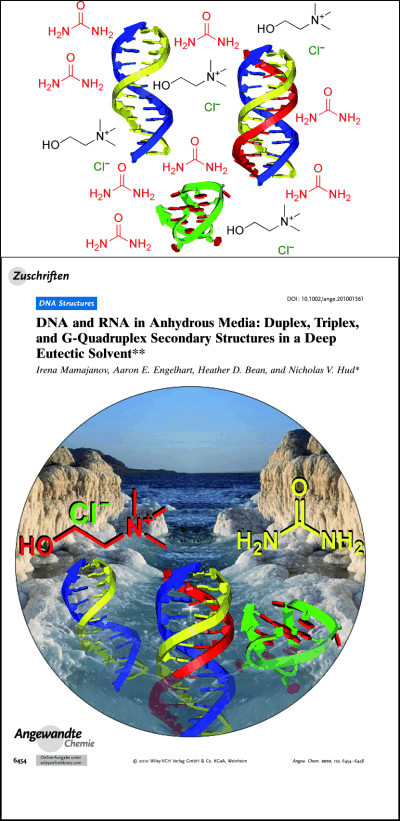DNA and RNA in Anhydrous Media: Duplex, Triplex, and G-Quadruplex Secondary Structures in a Deep Eutectic Solvent (featured on Frontispiece)
Irena Mamajanov, Aaron E. Engelhart, Heather D. Bean and Nicholas V. Hud
Angewandte Chemie International Edition in English, 2010, 49 (36), pp 6310-6314. doi: 10.1002/anie.201001561
Publisher | ResearchGate | PubMed | Google Scholar
Scientific Abstract
Deep-eutectic solvents (DESs) are nonvolatile media suitable for a wide range of chemical reactions. The discovery that nucleic acids can form duplex, triplex, and G-quadruplex structures (which in some cases differ from those adopted in aqueous media) in a water-free DES (see picture) opens the enticing possibility that catalytic nucleic acids and enzyme–nucleic acid complexes could also be used in these solvents.
Lay Abstract
Most solvents aren’t able to dissolve molecules like DNA and RNA, which have too many charges – water is somewhat unique in its ability to dissolve highly charged things. We found that a recently described class of solvents called “deep eutectic solvents” can dissolve DNA and RNA. Incredibly, the solvent we used is formed from two components that are solid at room temperature – urea and choline chloride, both of which melt at well above the boiling point of water. When mixed in a ratio of 2 urea molecules to 1 choline chloride, they form a mixture that is liquid at room temperature. We found that RNA and DNA not only dissolve in this solvent, but they form the same types of 3D structures they do in water. This suggests that it might be possible in the future to perform reactions where DNA or RNA acts as an enzyme (click here and here for two recent examples from our work) in conditions with almost no water around, enabling chemistry that wouldn’t be possible in aqueous solution.
